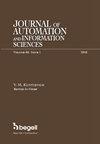稀疏密集通信网络层次结构优化问题的研究
Q3 Engineering
Journal of Automation and Information Sciences
Pub Date : 2021-01-01
DOI:10.34229/0572-2691-2021-1-1
引用次数: 1
摘要
本文研究了具有离散流和参数的多商品通信网络的分层结构在密度(网络中给定节点数的网络弧数与最大可能弧数之比)变化时的优化问题。网络有骨干、分区和内部三种层次结构和四种类型的节点——第一、二、三种类型的骨干节点,构成网络的骨干和分区层次;第四种类型的节点,从属于每个骨干节点,构成网络的内部层次。节点的类型在功能上彼此不同。研究的主要任务是建立骨干网的结构变化(第一、第二、第三类骨干网节点的数量和位置)、流量处理和分布方案以及不同密度下骨干网功能的技术经济指标。给出了三层网络中流的组织、排序和分配的原理及其数学模型。建立了骨干网结构优化问题的数学模型,并给出了流量的排序和分配方案。求解该问题的算法基于先前作者提出的局部下降法的离散模拟,考虑到待解问题的特殊性,从启发式考虑中选择可能解的度量空间的邻域。在包含100个节点的同构网络上,对该问题进行了计算机建模,其中节点的度数从2变化到99。利用计算机程序以货物运输的公路运输网为例进行建模,该程序是乌克兰国家科学院电信和全球信息空间研究所正在开发的信息和分析决策支持系统(IA DSS)工具软件的一部分。通过对该问题解决方案的实验研究表明,在保证高网络连通性的情况下,在节点数为9 ~ 14的情况下,实现了其功能的最佳技术、经济和运行指标,并显著缩短了货物到达收件人的平均时间和最长时间。所提出的解决网络密度变化问题的计算机技术允许对网络的各种选项进行交互建模,改变模型的拓扑、层次结构、流、参数和约束条件,并从所选结果族中选择最佳选项,同时考虑所选目标函数和可接受的约束条件;计算网络运行的初步技术经济指标,估计额外资源的成本,规划其结构要素现代化和建设所需的投资金额,最终通过优化其资源利用,降低流量处理和运输的运营成本,从而提高网络的效率功能。本文章由计算机程序翻译,如有差异,请以英文原文为准。
INVESTIGATION OF THE PROBLEM OF OPTIMIZATION OF THE HIERARCHICAL STRUCTURE OF A SPARSE AND DENSE COMMUNICATION NETWORK
The article is devoted to the study of the optimization problem for the hierarchical structure of a multicommodity communication network with discrete flows and parameters when its density changes (the ratio of the number of network arcs to the maximum possible number of arcs for a given number of nodes in the network). The network has three levels of hierarchy — a backbone, a zonal and a internal and four types of nodes — backbone nodes of the first, second and third types, forming the backbone and zonal levels of the network, and nodes of the fourth type, which subordinate to each backbone node and form the internal levels of the network. The types of nodes different from one another in functionality. The main task of the study is to establish how the structure of the backbone network changes (the number and location of backbone nodes of the first, second and third types), the scheme of processing and distribution of flows and technical and economic indicators of the network's functioning for various degrees of its density. The principles of organizing the sorting and distribution of flows in a three-level network and its mathematical model are given. A mathematical model of the problem of optimizing the structure of the backbone network and the schemes of sorting and distribution of flows is formulated. The algorithms for solving the problem are based on the discrete analogue of the local descent method proposed earlier by the authors, when the neighborhoods of the metric space of possible solutions are chosen from heuristic considerations, taking into account the peculiarities of the problem being solved. Computer modeling of the problem on a homogeneous network containing 100 nodes with a change in the degree of nodes from 2 to 99 is carried out. The modeling was carried out on the example of a road transport network for the transportation of cargo using a computer program, which is part of the instrumental software of the Information and Analytical Decision Support System (IA DSS), which is being developed at the Institute of Telecommunications and Global Information Space of the National Academy of Sciences of Ukraine. An experimental study of the solution to the problem showed that the best technical, economic and operational indicators of its functioning are achieved with a degree nodes from 9 to 14, when high network connectivity is ensured, and is significantly reduced the average and maximum time of delivery of cargos to recipients. The proposed computer technology for solving problem with changing network density allows you to interactively modeling various options of a network , changing the topology, hierarchical structure, flows, parameters and constraints of the model and from the family of the resived results choose the best option, taking into account the selected a goal function and the accepted constraints; calculate preliminary technical and economic indicators of the network's functioning, estimate the cost of additional resources and plan the amount of investment required for the modernization and construction of its structural elements, which ultimately makes it possible to increase the efficiency functioning of the network by optimizing use of its resources and reducing the operating costs for the processing and transportation of flows.
求助全文
通过发布文献求助,成功后即可免费获取论文全文。
去求助
来源期刊

Journal of Automation and Information Sciences
AUTOMATION & CONTROL SYSTEMS-
自引率
0.00%
发文量
0
审稿时长
6-12 weeks
期刊介绍:
This journal contains translations of papers from the Russian-language bimonthly "Mezhdunarodnyi nauchno-tekhnicheskiy zhurnal "Problemy upravleniya i informatiki". Subjects covered include information sciences such as pattern recognition, forecasting, identification and evaluation of complex systems, information security, fault diagnosis and reliability. In addition, the journal also deals with such automation subjects as adaptive, stochastic and optimal control, control and identification under uncertainty, robotics, and applications of user-friendly computers in management of economic, industrial, biological, and medical systems. The Journal of Automation and Information Sciences will appeal to professionals in control systems, communications, computers, engineering in biology and medicine, instrumentation and measurement, and those interested in the social implications of technology.
 求助内容:
求助内容: 应助结果提醒方式:
应助结果提醒方式:


